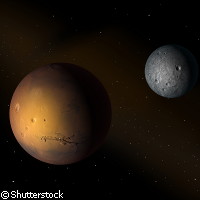Polish 'hamster' to extract soil from Martian moon
The Space Research Centre at the Polish Academy of Sciences (SRC PAS) in Warsaw, Poland has begun work on a unique 'geological penetrator' that will be used to extract a soil sample from the surface of Phobos, one of Mars' two moons. Dubbed 'CHOMIK' (which is Polish for hamster), the tool will contribute to the Russian space mission Phobos Sample Return. Due to be launched in 2011, the mission will give space scientists vital information about the mysterious Martian moon. The unique geological penetrator is being designed at the Space Mechatronics and Robotics Laboratory at the SRC PAS. CHOMIK's task of collecting the soil sample and returning it to Earth for analysis makes it one of the most important parts of the Phobos Sample Return mission. The spacecraft will be launched in November 2011. It will reach the orbit of Mars 11 months later and is scheduled to land on Phobos at the beginning of 2013. It will take off again a month later after extracting the soil sample that will be brought back to Earth in a secure capsule. If all goes well, the re-entry module will land in Kazakhstan in 2014. 'Assuming everything goes according to plan, in a few years we will be in possession of the first object acquired from a different planet's moon,' said SRC PAS engineer Karol Seweryn. Polish scientists will have the opportunity to participate in the analysis of the Phobos soil sample thanks to an agreement between the Russian Academy of Sciences and the Lavochkin Association (one of the largest Russian aerospace companies). Phobos orbits Mars at a distance of only 9,400 km, which is about 40 times less than the distance between the Earth and its moon. Phobos has been of great interest to space scientists for years because of its low density, low gravity and unusual orbit. A theory was even posited in the mid 20th century that it could be artificial - made by hypothetical Martians! Space scientists now know that Phobos is a natural object with probably both a solid and porous structure. Some scientists believe Phobos is similar to the outer part of the main asteroid belt between Mars and Jupiter, while other theories suggest that Phobos was not captured by Mars, but was in fact created in orbit after the planet was formed. 'The results of the sample collected by our penetrator will be crucial in solving the mystery of Phobos' origins,' commented Dr Joanna Gurgurewicz from SRC PAS. Although Phobos measures less than 30 km across, it is the larger of Mars' two moons and is the nearest to the planet. Its low gravity means it is attractive for space missions because the escape velocity of 11m/s means that landing and take-off are fairly simple. 'For the operators of a spacecraft, low gravity is an advantage. However, with a device that is supposed to be inserted into the soil, it becomes a major problem,' pointed out Professor Jerzy Grygorczuk, an engineer at SRC PAS. The low gravity on Phobos means that normally, every insertion of a penetrator into the soil would push the space lander away from the surface. However, because of its design, the CHOMIK penetrator will be able to insert itself into the soil with only minimal assistance from the lander. 'CHOMIK will collect the sample in the case that the moon's surface is too hard for other manipulators designed for loose soil,' Professor Grygorczuk said. The device will also measure the thermal and mechanical properties of the surface of Phobos. Work being carried out at SRC PAS contributes to the EU and European Space Agency's space programme. The organisation has taken part in many prestigious space missions, including designing sensors for the CASSINI mission which landed on Titan, the largest of Saturn's moons. Current projects include the development of a device called 'KRET', which will be used for geological studies of the Moon as part of the International Lunar Network. The KRET device has a unique mechanical structure which was designed and built by entirely by Polish scientists and engineers.
Countries
Poland



